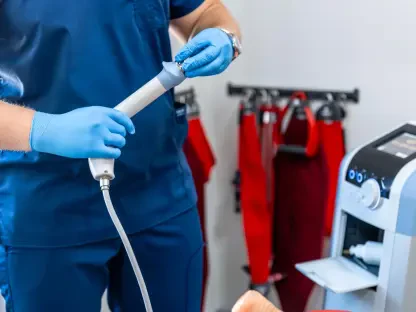In remote regions like Martinique, a French Overseas Department, the scarcity of dermatologists often leaves general practitioners as the primary caregivers for skin-related issues, creating a significant gap in specialized care that hinders effective treatment. This challenge is compounded by the unique needs of diverse phototypes and tropical environments, where tailored medical tools are scarce. Enter Dermagic, a clinical decision support system (CDSS) designed to bridge this divide by assisting physicians with reliable dermatological guidance. A recent study conducted in this Caribbean territory has shed light on the tool’s potential to transform healthcare delivery in underserved areas. By evaluating its usability and effectiveness among local doctors, the research offers a glimpse into how digital solutions might address systemic shortages. This exploration not only highlights a pressing issue but also raises questions about the broader applicability of such technology in similar settings worldwide.
Addressing Gaps in Dermatological Care
Challenges in Remote Healthcare Settings
The lack of specialized dermatologists in isolated regions like Martinique poses a persistent barrier to effective skin care, forcing many patients to rely on general practitioners who may lack specific expertise. These healthcare providers often face the daunting task of diagnosing and treating conditions influenced by tropical climates and varied skin types without adequate resources. The study evaluating Dermagic revealed that this shortage creates delays in accurate diagnosis and treatment, potentially worsening patient outcomes. Furthermore, the absence of tools designed for such unique contexts adds another layer of complexity. Dermagic steps into this void by offering a digital platform that supports clinical decisions, aiming to empower physicians with accessible and relevant information. This innovation could redefine how remote areas manage dermatological needs, providing a lifeline where specialist access remains limited. The urgency to address these gaps underscores the importance of integrating technology into healthcare systems that struggle with geographic and resource constraints.
Tailoring Solutions for Diverse Needs
Dermagic’s design specifically accounts for the diverse phototypes and environmental factors prevalent in tropical regions, making it a standout among clinical support tools. The research highlighted that over 95% of surveyed physicians recognized its adaptability to local dermatology challenges, a critical factor in a region with varied skin tones and conditions influenced by climate. This customization ensures that the tool isn’t just a generic solution but a targeted aid that aligns with the specific medical landscape of areas like Martinique. Beyond mere functionality, the system’s ability to cater to these unique requirements enhances trust among users, fostering greater adoption. As digital health solutions evolve, the emphasis on localized relevance could serve as a model for other regions facing similar issues. The potential to refine patient care through such tailored technology suggests a future where healthcare disparities in remote settings might be significantly reduced, paving the way for more equitable medical access.
Evaluating Dermagic’s Impact and Potential
User Acceptance and Usability Insights
The evaluation of Dermagic among 64 physicians in Martinique revealed an overwhelmingly positive reception, with nearly all respondents praising its quick accessibility and user-friendly interface. A striking 98.4% noted the tool’s ease of use, while every single participant acknowledged its role in improving prescription practices. The System Usability Scale (SUS) score of 87.7 out of 100 further confirmed its excellent design, reflecting a high level of satisfaction across medical specialties. Regular usage was reported by 62% of doctors, with many accessing it daily or weekly, indicating its integration into routine practice. This strong acceptance suggests that Dermagic not only meets a critical need but does so in a way that aligns with the workflow of busy healthcare providers. Such feedback underscores the tool’s immediate value in enhancing clinical decision-making, particularly in a region where specialist input is often out of reach, highlighting a promising step forward for digital health interventions.
Scalability and Future Enhancements
Looking beyond its current success, Dermagic holds potential for broader application in other Francophone or tropical regions facing similar healthcare challenges. The study’s authors proposed cross-regional evaluations to test adaptability, alongside the integration of artificial intelligence to bolster diagnostic capabilities. Addressing underused features through targeted updates could further refine its utility, ensuring it remains relevant across diverse settings. Independent validation studies were also suggested to strengthen credibility and mitigate limitations like the modest sample size of the initial research. These forward-thinking strategies aim to transform Dermagic from a localized tool into a global asset for remote healthcare. As technology continues to shape medical practice, the focus on scalability and innovation could position this system as a cornerstone in tackling dermatological care shortages worldwide, offering a blueprint for sustainable digital health solutions.
Reflecting on a Path Forward
The journey of Dermagic in Martinique painted a picture of hope, as it proved to be a reliable ally for physicians grappling with limited dermatology resources in a remote tropical setting. Its high usability and widespread satisfaction among users marked a significant stride in supporting clinical decisions where specialists were scarce. The tailored approach to diverse phototypes and local conditions stood out as a key strength, addressing long-standing gaps in care. Looking back, the study’s insights paved a clear path for actionable next steps, such as expanding testing to other regions and incorporating advanced technologies for even greater impact. These efforts promised to build on the tool’s initial success, ensuring it adapted to evolving healthcare needs. The narrative of this digital solution contributed to a larger conversation about leveraging technology to overcome systemic barriers, offering a model that could inspire similar innovations in underserved communities globally.









